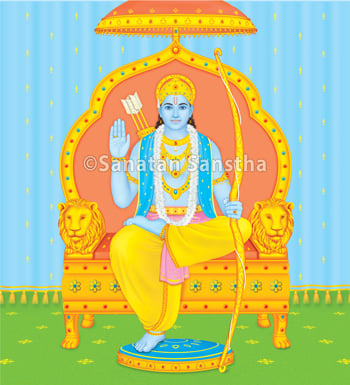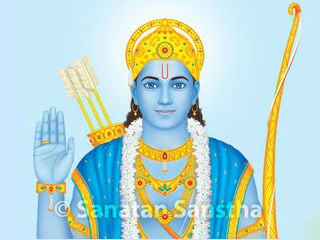
Index
1. Origin of some names of Shriram
2. Shriram : Ideal in all respects
3. Follower of Righteousness (Dharma)
4. One who honours His word (ekavachani)
5. One who used a single arrow
7. Implied meaning of Ramrajya (Ram’s kingdom)
9. Seekers and the worship of Shriram
The little that most people know about God is usually through stories read or heard during their childhood. Due to such brief information, their belief in God is also very little.
Availability of more information about Deities helps in augmenting one’s belief; this in turn assists in smooth spiritual practice. Therefore, useful information about Shriram is given in this article.
Just as a droplet of water containing a trace of oil cannot blend with water completely, similarly unless the devotee of Shriram has imbibed all the attributes of Shriram, he cannot merge with Him, that is he cannot attain Sayujya Mukti. In this context, the attributes of Shriram described here will be a source of guidance to seekers.
Origin of some names of Shriram
Ram
This name was prevalent even before Ram’s birth.
Ramchandra
Ram’s original name is ‘Ram’ only. He belongs to the Sun dynasty. Although He was born at twelve noon, He was not named Rambhanu, etc. (after the Sun god). He was named Ramchandra probably after an incident, when in His early childhood, He insisted on having the moon (chandra) !
Shriram
After His victory at Lanka, when Ram returned with Sita to Ayodhya, He began to be addressed as Shriram. ‘Shri’ is an adjective for God. Upon Ram demonstrating His Godhood, everyone started addressing Him as Shriram.
Shriram : Ideal in all respects
Ideal Brother
Even today, people cite Shriram’s relationship with His brother Lakshman, as the ideal of brotherly love.
Ideal husband
Shriram had taken a vow of perfect chastity. After renouncing Sita, Shriram led a life of detachment. Later, when He performed a sacrificial fire (yadnya), He placed Sita’s Idol by his side, instead of marrying again. Shriram’s devotion towards His only wife, would be clear from this episode. In those days, it was customary for kings to have several wives. Against this backdrop, Shriram’s vow stands out as a shining example.
Ideal friend
Shriram helped Sugriva, Bibhishan, etc. in their times of crises.
Ideal king
When His subjects expressed their doubts about Sita, He renounced Her, giving priority to His duty as a King. Kalidas has written a touching verse on this incident :
‘कौलिनभीते न गृहन्निरस्ता न तेन वैदेहसुता मनस्तः ।’
Meaning : Fearing public censure, Shriram sent Sita out of the house but not out of His heart.
Ideal enemy
After Ravan’s death, when his own brother Bibhishan was not ready to perform the last rites, Shriram said to him, ‘All enmity ceases upon death. If you do not perform the last rites, I will. Ravan is my brother too.’
Follower of Righteousness (Dharma)
He observed all the codes of Righteousness; that is why he is referred to as ‘Maryadapurushottam’.
One who honours His word (ekavachani)
1. When one has to emphasise that a particular point is the Truth, one often says it thrice. For example, the word ‘Shanti’ is also uttered thrice as in ‘शांतिः । शांतिः । शांतिः ।’
The term ‘three times (trivar)’ is used with the following two meanings,
a. It is considered as an oath of the Holy Trinity, Brahma (Deity of creation), Vishnu (Deity of sustenance) and Mahesh (Deity of dissolution).
b. The word trivar is derived from tri (three) + var (day / times). If one has the same dream on three consecutive nights, it is considered to be a ‘vision in a dream’ and not merely a dream. In such an event, it is necessary to act accordingly or consult a spiritually evolved person. Similarly, if one hears something three times, then it must be considered as the truth; however, whatever Shriram spoke was the Truth, albeit it was spoken only once. He did not have to repeat thrice for emphasis.
2. In Sanskrut grammar, there are three types of speech – singular, dual and plural. In a way, Shriram is related to singular speech. This implies that if one is to unite with Shriram one has to go from three (plural) to one. In Spirituality, as one progresses, one goes from many to One and then from One to Zero. Here, Zero refers to the complete Incarnate Shrikrushna.
One who used a single arrow
Since Ram could hit the target with just one arrow, there was never a need for a second one.
Humane
Since Ram exhibits happiness and unhappiness like humans, He appears closer to us when compared to other Gods. For example, upon Sita’s abduction, Shriram was in intense grief. Yet, how His Godhood is proved even from such an incident, would be clear from the following conversation between Shiva and Parvati.
Parvati : You chant His Name, but look at Him grieving for His wife like a common man.
Shiva : The grief you see is superficial. He has taken human birth, He has to behave accordingly.
Parvati : He goes about embracing trees; He has become truly insane for Sita.
Shiva : You will know whether what I say is true or false. In the guise of Sita, go and meet Ram and see how He behaves.
Hence, Parvati set out to meet Ram as per Shiva’s instructions. Upon seeing Her, Ram bowed before Her and said, ‘I have recognised You, O Adimaya.’ Hearing this Parvati was convinced that His grief was superficial.
Implied meaning of Ramrajya (Ram’s kingdom)
The real kingdom of Ram refers to the rule of Shriram [who dwells within oneself or the soul principle (Atma Ram)] over the five sense organs, the five motor organs, the conscious mind, the subconscious mind, the intellect and the ego (aham).
Ramayan
Origin and meaning
1. The word ‘Ramayan’ is derived from ‘ram’ and ‘ayan’. ‘Ram-ramayate’ means to be engrossed. The experience of Bliss is related to ‘being engrossed in spiritual practice’. Ayan refers to the seven regions (saptalok). Thus, Ramayan teaches how to be engrossed in spiritual practice, i.e. Bliss and cross the seven regions to achieve the Final Liberation (Moksha).
2. ‘Samasya ayanam Ramayanam’. Here, ayan would mean to go, the motion or the path. That which takes one towards Shriram, who is the form of Parabrahman, Paramatma that which provides the enthusiasm, speeds up the process to reach there and shows the real path of life, is ‘Ramayan’. ‘Ramayan’ is that which chiefly narrates the story of the victory of Righteousness (Shriram) over unrighteousness (Ravan). Ayan also means a place of refuge; hence wherever Shriram exists, there is Ramayan.
Different Ramayans
1. Purva (pre) Ramayan and Uttar (post) Ramayan
The manner in which spiritual practice of the bijamantra ‘ram’ helps the journey across the ayan (seven regions) is described in the Purva Ramayan; whereas the Uttar Ramayan describes the life of Shriram who followed this type of spiritual practice.
2. Adhyatma Ramayan
This is in the form of a conversation between Maheshvar (Shiva) and His consort, Uma. Uma prays thus to Shiva, ‘The Path of Devotion (Bhaktiyoga) is the best way to attain the Supreme God, but since many have put forth various opinions, His true form (svarup) is not clear to me. Be gracious and let me know His true form.’ In reply, Shiva narrated the Adhyatma Ramayan.
Implied meaning of names in Ramayan
1. Dasharath : Dasharath is derived from two words, dasha + rath. Dasha means ten and rath refers to the body. Thus, Dasharath means the body with ten organs, i.e. the five sense organs and the five motor organs.
2. Lav : One who gracefully bows as the wind blows and hence does not break; one who can endure all circumstances.
3. Kush : This is a kind of grass. One which can grow under any circumstances, even on rocks.
4. Lanka : Lanka refers to the portion of the body above the neck, i.e. the head. Shriram handed over the kingdom of Lanka to Bibhishan, meaning He made Bibhishan progress spiritually upto the Sahasrar chakra (seventh centre in the spiritual energy flow system, situated at the crown of the head).
5. Indrajit : Indrajit was Jitendriya, i.e. he had control over all his organs.
Implied meaning of some incidents in Ramayan
Sita, daughter of the earth
Incident : Sita was found when the land was being ploughed.
Implied meaning : The infant Sita was the manifest form of Hiranyagarbha waves emanating from the core of the earth. The energies associated with word, touch, form, taste and smell exist in harmony. Therefore, when even one of the attributes is present, all the others also exist. For example, when a name is pronounced, the corresponding form, smell, etc. also come to mind. Similarly, the infant Sita was the manifest form of that specific Hiranyagarbha energy. Sita (the wife of Shriram) represented Shriram’s primal (spiritual) energy.
Kaikeyi asking for a boon
Incident : With one boon Kaikeyi asked for Ram to be exiled into the forest for fourteen years and with the second boon, she wanted her son, Bharat to be made the king.
Implied meaning : Sage Dhaumya was Shravankumar’s grandfather and Ratnavali and Ratnarushi were his parents. Ratnarushi was the royal priest of King Ashvapati of Nandigram. Kaikeyi was King Ashvapati’s daughter. Ratnarushi had taught Kaikeyi all the scriptures and had also told her that if King Dasharath did have any progeny, they would not be able to ascend the throne. If anyone of them did ascend the throne during the period of fourteen years upon Dasharath’s death, the Raghu dynasty would come to an end. To prevent this misfortune, Sage Vasishtha later made Kaikeyi ask Dasharath for these boons. By asking for the first boon, she sent Ram to the forest for fourteen years and with the other, asked for Bharat to be made the king. She knew fully well that as long as Ram lived, Bharat would never agree to be the king, i.e. never ascend the throne. Then, again at Sage Vasishtha’s behest, Bharat installed Ram’s Holy footwear (paduka) on the throne, instead of His Idol. Had Ram’s Idol been placed on the throne, then by the precept that word, touch, form, taste and smell exist in harmony, the effect would have been just as if Shriram had Himself ascended the throne.
In the original Valmiki Ramayan, there are three verses to this effect. But some scholars say that those who wrote Ramayan after 1228 A.D. did not include these verses.
Bharat asking for Shriram’s Holy footwear
‘Asking for Paduka (Holy footwear)’ implies ‘bowing at that person’s feet’ or ‘complete surrender.’ Upon being asked, Shriram gave HisHoly footwear to Bharat. Bharat carried the Holy footwear on his head, keeping the toe pointing forwards and placing them on the throne, began their worship. The ritual of worshipping of Holy footwear began from that time.
Bharat’s stay at Nandigram
1. Incident : Upon receiving Shriram’s Holy footwear, Bharat took them to Nandigram and installed them there. He did not go back to Ayodhya.
Implied meaning : Nandigram symbolises the scrotum, thereby meaning, Bharat lived as a celibate. ‘Installation of Shriram’s Holy footwear’ signified that Bharat lived the life of a seeker.
2. Incident : Whilst receiving Shriram’s Holy footwear, Bharat prayed to Him to let him know one day in advance, of His arrival with Sita so that he could make preparations. Upon this, Shriram said, “So be it.”
Implied meaning : ‘With Sita’, means along with energy, thereby meaning ‘after the activation of spiritual energy (kundalini)’. ‘Before arrival’ means ‘before attaining Self-realisation, i.e. before entering the nirbij samadhi (superconscious state)’, Bharat wanted to know in advance when he would enter that state.
Lakshman’s life during exile
Incident : Since Lakshman would go to fetch roots and tubers, Sita would assume that he must have eaten. On the other hand, Ram thought that Sita must have served Lakshman; so both of Them never enquired about Lakshman’s meals.
Implied meaning : For fourteen years, Lakshman survived only on air. In order to protect Shriram, he did not sleep. Instead, he did his spiritual practice continuously.
Sita’s abduction
Incident : Ravan abducted Sita and kept Her with him.
Implied meaning : The real Sita never went to Ravan; she entered the fire. It was only Sita’s image that went with Ravan. In the true sense, this marked the beginning of Ramlila (Ram’s Divine play). Later, upon returning from Ravan’s captivity, the image (which was with Ravan) entered the fire again on the pretext of being purified and the real Sita emerged from it.
Shriram embracing trees
Incident : After Sita’s abduction, Ram went about embracing trees, crying out ‘Sita, Sita’.
Implied meaning : He came to know what the trees felt (upon Sita’s abduction).
Slaying of Vali
Incident : Shriram shot an arrow into Vali’s chest and thus killed him.
Implied meaning : Vali’s spiritual progress was stuck at the Anahat chakra (the fourth centre in the spiritual energy flow system, situated near the heart). Shriram’s arrow restarted his spiritual progress and he was liberated.
Rajak accusing Sita
Incident : A washer-man named Rajak said that Sita was unchaste; so Shriram renounced her.
Implied meaning 1 : The one accusing Sita, Rajak, is depicted as a washer-man. The work of a washer-man is to wash clothes and make them clean and stain free. The washer-man said this, so that Shriram’s reputation remained unblemished.
Implied meaning 2 : The washer-man’s name is ‘Rajak’, which is derived from the words ‘raja’ and ‘ka’. The letter ‘ka’ denotes a fraction of an object; which means that the washer-man had a fraction of the raja component in him; which is why he did not realise Sita’s sattvik (sattva predominant) nature.
Shriram renouncing His body in water (jalasamadhi)
Incident : After Sita re-entered in Mother Earth, Shriram gave up His life in the Sharayu river.
Implied meaning : Shriram did not give up His life in the Sharayu river, but renounced His body and took jalasamadhi (a type of Mahasamadhi, lit. great samadhi).
There are various types of Mahasamadhi – samadhi by entering the earth (bhumisamadhi), in the water (jalasamadhi), in the fire (agnisamadhi), etc. Saint Eknath and Saint Ramtirtha also took jalasamadhi. This is possible only for those who have no attachment to the body.
After Shriram, all the residents of Ayodhya also took jalasamadhi in the Sharayu river; because, after Shriram’s renunciation of His body, they felt that there was no more ‘Ram’ in their lives (meaning, their life was meaningless).
Seekers and the worship of Shriram
The chant ‘Hare Ram’
Since the Kalisantaran Upanishad is from Krushnayajurveda, it is also known as Harinamopanishad. This Upanishad was narrated by Brahma to Sage Narad at the end of Dvaparyug (the third of the four eras). In brief, this means that all sins in Kali (referring to Kaliyug, the fourth era of strife) are burnt by merely chanting the Name of Narayan.

 Virtuous Bharat, a jewel in the crown of devotees of Shriram
Virtuous Bharat, a jewel in the crown of devotees of Shriram A stone and a coin from the era of Shriram !
A stone and a coin from the era of Shriram ! Rangolis that attract and emit Shriram tattva
Rangolis that attract and emit Shriram tattva Worship of Shriram
Worship of Shriram